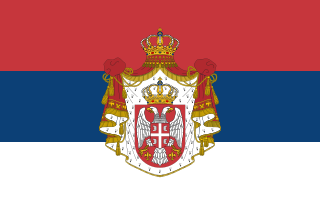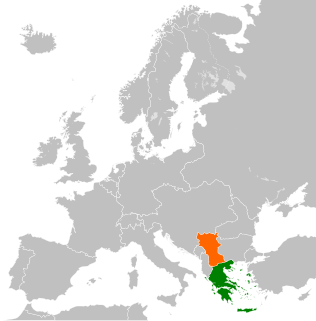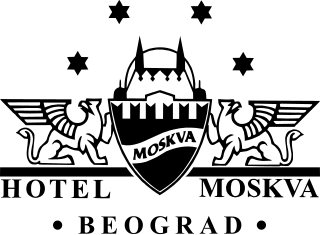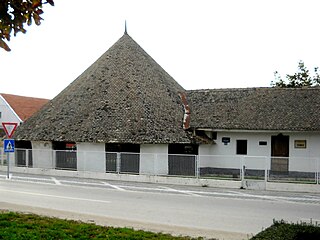 W
WThe Kingdom of Serbia was a country located in the Balkans which was created when the ruler of the Principality of Serbia, Milan I was proclaimed king in 1882.
 W
WThe Ambassador of the Kingdom of Serbia to the United Kingdom was the official representative of the Government of the Kingdom of Serbia to the Government of the United Kingdom of Great Britain and Northern Ireland from 1883 to 1918.
 W
WThe League of Balkans was a quadruple alliance formed by a series of bilateral treaties concluded in 1912 between the Eastern Orthodox kingdoms of Greece, Bulgaria, Serbia and Montenegro, and directed against the Ottoman Empire, which at the time still controlled much of Southeastern Europe.
 W
WUnification or Death, popularly known as the Black Hand, was a secret military society formed in 1901 by officers in the Army of the Kingdom of Serbia, best known for being allegedly involved in assassination of Archduke Franz Ferdinand in Sarajevo and the earlier conspiracy to assassinate the Serbian royal couple in 1903, under the aegis of Captain Dragutin Dimitrijević.
 W
WThe Corfu Declaration is the agreement that made the creation of the Kingdom of Yugoslavia possible.
 W
WThe Greek–Serbian Alliance of 1913 was signed at Thessaloniki on 1 June 1913, in the aftermath of the First Balkan War, when both countries wanted to preserve their gains in Macedonia from Bulgarian expansionism. The treaty formed the cornerstone of Greek–Serbian relations for a decade, remaining in force through World War I until 1924.
 W
WHotel Bristol is one of the oldest hotels in Belgrade, the capital of Serbia. Built in 1912, it is an anthological exemplar of the modern architecture in Belgrade and represents the pinnacle of the Secession architecture in the city. The building was declared a cultural monument in 1987.
 W
WHotel Moskva is a four star hotel in Belgrade, one of the oldest currently operating in Serbia. The building has been under governmental protection since 1968. Originally operating as a 36-room inn within the multipurpose Palace Rossiya, whose almost 3-year construction and January 1908 opening represented a major investment of the Russian Empire in the Kingdom of Serbia economy, Hotel Moskva eventually expanded its facilities to take up the entire palace.
 W
WThe Metropolitanate of Belgrade was a metropolitanate of the Serbian Orthodox Church which existed between 1831 and 1920, with jurisdiction over the territory of Principality and Kingdom of Serbia. It was formed in 1831, when the Ecumenical Patriarchate of Constantinople granted church autonomy to the Principality of Serbia. Territorial enlargement and full canonical autocephaly were gained in 1879. The Metropolitanate of Belgrade existed until 1920, when it was merged with Patriarchate of Karlovci and other Serbian ecclesiastical provinces to form the united Serbian Orthodox Church. The seat of the Metropolitanate was in Belgrade, Serbia.
 W
WOld Serbia is a term in Serbian historiographical discourse that is used to describe the territory that according to the dominant school of Serbian historiography in the late 19th century formed the core of the Serbian Empire in 1346-71.
 W
WThe Order of the Red Cross was a military decoration of the Kingdom of Serbia, Kingdom of Serbs, Croats and Slovenes and Kingdom of Yugoslavia. Established in 1876 and first awarded in 1877 by the Serbian Red Cross Society, it was awarded for exceptionnal care of the wounded and sick during war time. Decorations of the Serbian Red Cross Society had the rank of state decorations.
 W
WThe powder keg of Europe or Balkan powder keg was the Balkans in the early part of the 20th century preceding World War I. There were a number of overlapping claims to territories and spheres of influence between the major European powers such as the Russian Empire, the Austro-Hungarian Empire, the German Empire and, to a lesser degree, the Ottoman Empire, the United Kingdom and Kingdom of Italy.
 W
WThe Red Cross Medal of Merit was awarded to men and women, Serbian and foreign nationals, in two Classes. Decorations of the Serbian Red Cross Society had the rank of state decorations.
 W
WSerbia and Albania: A Contribution to the Critique of the Conqueror Policy of the Serbian Bourgeoisie is a book by Serbian socialist Dimitrije Tucović, in which he analyzes the roots of Serbian-Albanian conflict.
 W
WThe Serbian Academy of Sciences and Arts is a national academy and the most prominent academic institution in Serbia, founded in 1841 as Society Of Serbian Letters.
 W
WSerbian–Montenegrin unionism is a political ideology which arose during Montenegro's affiliation with the Federal Republic of Yugoslavia and the State Union of Serbia and Montenegro. It advocates Montenegro being in a federal political union with Serbia and opposes Montenegrin independence and separation from Serbia. The relationship between Serbs and Montenegrins is generally identified as being the most amicable of all the peoples of the former Yugoslavia.
 W
WThe Modern Serbo-Byzantine architectural style, Neo-Byzantine architectural style or Serbian national architectural style is the style in Serbian architecture which lasted from the second half of the 19th century to the first half of the 20th century. This style originated in the tradition of medieval Serbian-Byzantine school and was part of international Neo-Byzantine style.
 W
WThe Society of Saint Sava or Saint Sava Society was a Serbian non-governmental association with the aim of maintaining and protecting the Serb people in the Ottoman Empire, in Old Serbia and Macedonia, and in Austro-Hungarian Bosnia and Herzegovina, founded in 1886 in Belgrade, the capital of the Kingdom of Serbia. It was active, with a brief pause during the First World War, until the Invasion of Yugoslavia (1941).
 W
WSouth Serbia was a province (pokrajina) of the Kingdom of Serbs, Croats and Slovenes that existed between 1919 and 1922. It encompassed the modern territories of Sandžak, Kosovo and North Macedonia. The term "Old Serbia", was historically used in Serbian politics, literature and science for the territories of the province. The term continued in use for the Vardar Banovina and Zeta Banovina following its disestablishment.
 W
WSuvača in Kikinda, Serbia, is one of the three remaining horse-powered dry mills in the whole of Europe.